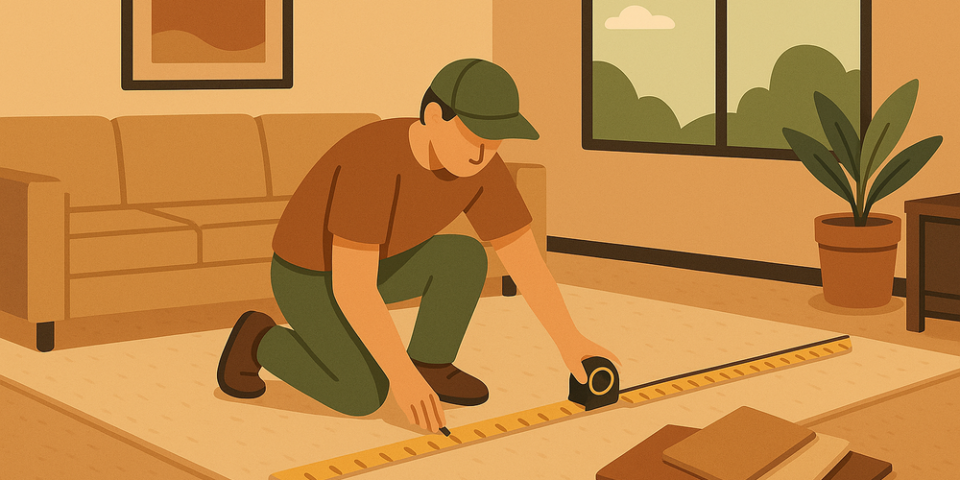
How Much Is Carpet Per Square Foot? A Complete Guide
Carpet is one of the most budget-friendly and cozy flooring options for homeowners—but prices can vary based on style, material, and labor. Whether you’re planning a single-room upgrade or a whole-home refresh, this guide breaks down how much carpet costs per square foot and what other factors to consider.
Average Carpet Cost Per Square Foot
On average, most carpets cost between $2 to $7 per square foot for the material alone. Here’s a quick breakdown:
- Low-End Carpet: $0.75 – $2.50/sq ft (basic polyester or olefin)
- Mid-Range Carpet: $2.50 – $5.00/sq ft (textured plush, nylon blends)
- High-End Carpet: $5.00 – $12.00/sq ft (wool, designer brands, stain-resistant fibers)
Keep in mind this doesn’t include padding or installation.
Carpet Installation Cost Per Square Foot
Installation typically adds $1 to $3 per square foot depending on:
- Room shape and size
- Old flooring removal
- Furniture moving
- Type of carpet backing
So, if you’re budgeting for both carpet and install, expect to spend about $3 to $10 per square foot total.
How Much Carpet Do You Actually Need?
To estimate the amount of carpet you’ll need, follow this formula:
- Measure the length and width of each room (in feet)
- Multiply to get the square footage (L × W)
- Add 10% for waste, seams, or cutting adjustments
Example: A 12’ x 14’ bedroom = 168 sq ft. Add 10%, and you’ll need about 185 sq ft of carpet.
What Other Materials Do You Need?
Besides carpet itself, here’s what else you’ll need—and what it might cost:
- Carpet Padding: $0.50 – $1.25/sq ft
Important for comfort and extending carpet life - Tack Strips: ~$0.50 per linear foot
- Seam Tape & Glue: ~$0.25 – $0.75 per sq ft (for larger rooms or patterned carpet)
- Transition Strips: $10 – $30 each (for doorways and transitions to other floors)
Factors That Affect Carpet Pricing
- Fiber Type: Nylon is more durable and expensive than polyester
- Pile Height: Plush or high-pile carpet costs more than low-pile or Berber
- Stain Resistance: Treated carpets (like Scotchgard) add to the cost
- Warranty: Premium warranties increase the base price
Where to Save (and Where to Spend)
If you’re on a tight budget, consider spending more on a good pad and mid-range carpet instead of splurging on luxury fibers. A quality pad improves soundproofing and keeps even affordable carpet feeling great underfoot.
How Much to Carpet an Average Room?
Let’s break it down:
| Room Size | Material Only | With Install |
|---|---|---|
| 10’ x 12’ (120 sq ft) | $240 – $840 | $360 – $1,200 |
| 12’ x 14’ (168 sq ft) | $336 – $1,176 | $504 – $1,680 |
| Living Room (300 sq ft) | $600 – $2,100 | $900 – $3,000 |
Need Help Choosing the Right Carpet?
Check out our posts on:
- Whether you really need carpet padding
- The best options for busy households
- Replacing carpet before selling
Conclusion
When shopping for new carpet, think beyond the price tag. Between material, padding, installation, and room size, the cost per square foot can vary widely. Use this guide to estimate your budget—and feel confident choosing what works best for your home.
Need help measuring or planning your next flooring project?
Browse our carpet options or talk to our team for free advice and personalized quotes.
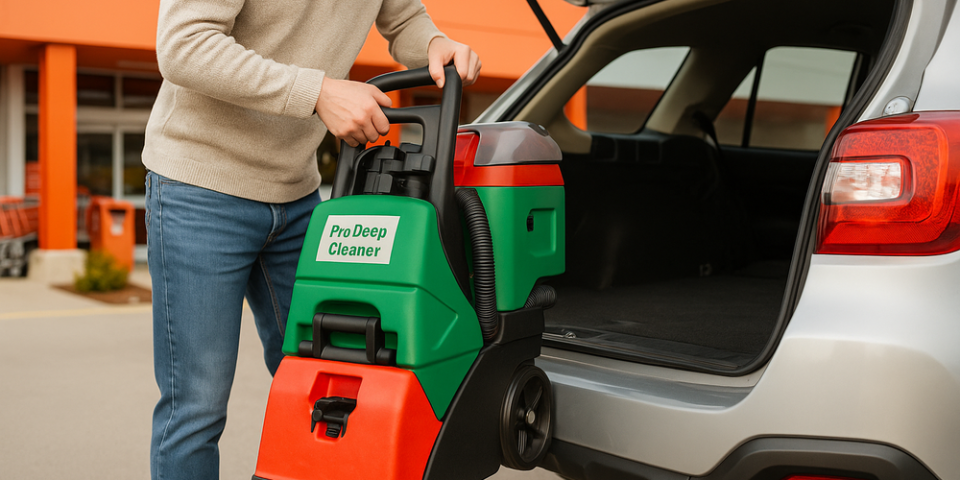
Where Can I Rent a Carpet Cleaner?
Need a deep clean but don’t want to buy a carpet cleaner? Renting one is a great option for occasional or one-time use. In this guide, we’ll cover where to rent a carpet cleaner, how much it costs, and what to expect during the process.
Top Places to Rent a Carpet Cleaner
1. Hardware & Home Improvement Stores
- Home Depot: Offers Rug Doctor and BISSELL rentals by the hour or day
- Lowe’s: Commonly provides deep-cleaning machines in-store
2. Grocery Stores
Many large grocery chains, such as Kroger, Safeway, and Walmart, partner with rental kiosks for carpet cleaners near the front of the store.
3. Big-Box Retailers
Stores like Walmart often have rental stations near the customer service desk. Machines are typically self-service and come with a manual or QR code.
4. Local Tool & Equipment Rental Shops
Independent shops often rent out professional-grade cleaners, sometimes with stronger suction or larger capacity than consumer models.
How Much Does It Cost?
- 24-Hour Rentals: Around $30–$40
- Cleaning Solutions: $10–$25 (usually sold separately)
- Deposit: Some locations require a refundable deposit of $20–$50
What to Know Before Renting
- 📅 Call ahead to check availability, especially during weekends or holidays
- 🧼 You’ll need to purchase compatible cleaning solution—some stores sell packages together
- 📏 Know the square footage you plan to clean so you get the right size machine
Should You Rent or Hire a Pro?
Rental is a good choice if:
- You’re comfortable lifting and operating equipment
- You only need to clean a few rooms
- You want to save on professional cleaning costs
If you’re dealing with deep stains, pet odor, or large homes, a professional cleaning service may be more efficient.
Bonus Tip: Do a Test Spot
Always test the machine on a small, hidden area of carpet before cleaning the whole room—especially if your carpet is wool, vintage, or delicate.
Related Posts
See our blog on cleaning tough stains or removing pet odors.
Conclusion
Renting a carpet cleaner is simple, affordable, and perfect for seasonal deep cleaning. Whether you visit a big-box store or a local shop, you’ll find plenty of options to refresh your floors.
Thinking about replacing your carpet instead?
Browse our flooring catalog or contact Carpet Cave for help choosing a new look.

How to Clean Vomit from Carpet
Let’s face it—cleaning vomit is one of the least pleasant tasks. But when it happens on carpet, quick action makes all the difference. In this post, we’ll walk you through how to clean vomit from carpet without leaving behind stains or smells.
Step 1: Remove Solids Immediately
Put on gloves and use a paper towel, dustpan, or plastic scraper to gently lift up solids. Avoid pushing the mess deeper into the carpet fibers.
Step 2: Blot the Area
Use a clean towel or cloth to blot up any remaining liquid. Do not rub—it can spread the stain and damage the fibers.
Step 3: Apply a Vinegar + Water Solution
Mix equal parts white vinegar and cold water in a spray bottle. Spray the area and let it sit for 5–10 minutes to neutralize odors and loosen particles.
Step 4: Blot Again and Rinse
Blot the area again with a clean towel. You can rinse lightly with water to remove the vinegar mixture, then blot until nearly dry.
Step 5: Sprinkle Baking Soda
Once the area is damp, sprinkle baking soda over the spot. Let it sit for several hours or overnight. This helps absorb odors and lingering moisture.
Step 6: Vacuum
Vacuum the baking soda thoroughly. You may want to use a carpet-safe deodorizing powder as a final touch if any odor remains.
For Persistent Smells
- Use an enzyme cleaner designed for biological messes
- Try steam cleaning for deep removal
- Repeat vinegar + baking soda cycle if needed
What Not to Use
- ❌ Bleach – can damage carpet and leave residue
- ❌ Hot water – can set stains and odors
- ❌ Strong perfumes – may mask instead of remove odor
Need More Cleaning Tips?
Check out our blog on removing urine odor or see how to deodorize carpet naturally.
Conclusion
Cleaning vomit from carpet isn’t fun—but it’s manageable with the right steps. By acting quickly and using gentle, odor-neutralizing products, you can keep your carpet fresh and clean.
Need flooring that’s easier to clean?
Browse our catalog or get in touch with Carpet Cave for durable, stain-resistant options.
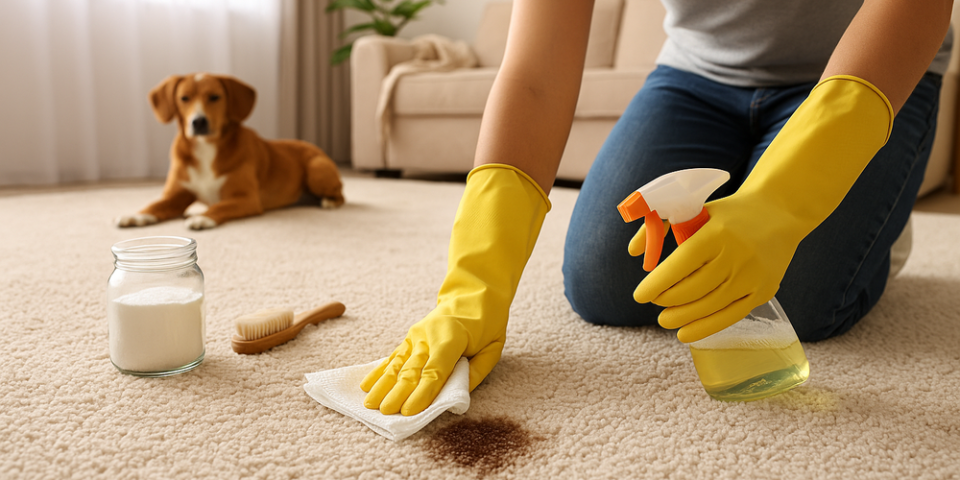
How to Get Pee Smell Out of Carpet
Accidents happen—whether it’s from a pet or a potty-training toddler. But urine odors in carpet can linger if not treated properly. In this guide, we’ll walk you through the best ways to remove pee smells from carpet, using safe and effective methods that actually work.
Step 1: Blot Immediately
If the spot is still fresh, blot it with paper towels or a clean cloth. Press down gently to absorb as much liquid as possible. Don’t rub—it can push the urine deeper into the fibers.
Step 2: Use a Vinegar Solution
Mix one part white vinegar with one part water in a spray bottle. Lightly spray the affected area and let it sit for 5–10 minutes. Vinegar neutralizes the ammonia smell in urine.
Step 3: Blot Again
After letting the vinegar soak in, blot the area again with a clean, dry cloth. The smell should start to fade as the vinegar lifts the odor.
Step 4: Sprinkle Baking Soda
Once the area is mostly dry, sprinkle a layer of baking soda over it. Let the baking soda sit for a few hours (or overnight if possible). It will absorb lingering odors.
Step 5: Vacuum Thoroughly
Vacuum up the baking soda to finish the process. If the smell persists, repeat the steps or use an enzymatic cleaner designed for pet accidents.
Bonus: Try Enzyme Cleaners
Enzyme-based cleaners break down proteins in urine, which is the key to removing long-lasting odors. Look for pet-safe products and follow the label instructions closely.
Tips to Prevent Future Smells
- Address accidents quickly—odor is harder to remove once it sets
- Use a carpet-safe deodorizer weekly in high-traffic pet areas
- Consider stain-resistant or waterproof carpet if accidents are frequent
Looking for More Carpet Tips?
Check out our guide on natural carpet deodorizing or how to keep your carpet looking new.
Conclusion
Getting pee smell out of carpet isn’t impossible—it just takes quick action and the right products. From vinegar to enzyme cleaners, there are easy ways to refresh your carpet and your space.
Need help choosing odor-resistant carpet?
Browse our catalog or contact Carpet Cave for personalized recommendations.

Should You Replace Carpet Before Selling Your Home?
Thinking of selling your home? You may be wondering if it’s worth replacing your carpet before listing. While not every home needs a flooring upgrade, old or worn-out carpet can affect buyer perception and even the final sale price. Here’s how to decide whether new carpet is the right move—and how to get the best return on your investment.
Why Carpet Matters When Selling
First impressions matter. When buyers walk into your home, the condition of your floors can say a lot. Fresh, clean carpet makes your space feel newer, well-maintained, and move-in ready. On the flip side, stained, matted, or outdated carpet can raise red flags—even if the rest of the home is in great shape.
When You Should Replace the Carpet
- Visible stains, odors, or damage: Pet smells, wine stains, or general wear will be noticed right away.
- Outdated styles or colors: Shag or bright-colored carpet from the early 2000s may turn off buyers.
- Heavy traffic areas: If the hallway or living room looks worn down, consider replacing it for a more cohesive look.
When You Might Not Need to Replace It
- It’s less than 5 years old and in great shape
- You’ve had it professionally cleaned
- You’re in a hot real estate market where buyers are more flexible
In these cases, a deep cleaning might be enough. Be honest with your real estate agent about the condition and whether it’s worth the upgrade.
How New Carpet Can Help You Sell Faster
Replacing carpet isn’t just about looks—it helps potential buyers emotionally connect with your home. It also signals that the house has been cared for and reduces the list of things a new owner might need to fix right away.
- Boosts curb-to-core appeal during showings
- Makes staging easier and more effective
- Minimizes negotiation points during offers
What Type of Carpet Sells Best?
Keep it neutral, soft, and durable. Here’s what works best:
- Color: Light grays, taupes, and warm beiges work well with most staging and décor
- Style: Textured plush or low-pile carpets are clean, subtle, and appealing to a broad audience
- Fiber: Nylon or polyester are budget-friendly and durable for listing-ready upgrades
Should You Replace Carpet in Just One Room?
Yes—if that one room looks significantly worse than the rest. Consistency matters, but you don’t have to re-carpet the whole home. Stick with neutral tones that blend well with surrounding flooring to avoid a patchy look.
Want More Tips on Carpet Maintenance?
Read our guide on how to keep your carpet looking new or see our post on carpet styles for small spaces.
Conclusion
Replacing carpet before selling your home can make a big difference—especially if it’s stained, outdated, or distracting from your home’s best features. A modest investment in flooring can often help your home sell faster and closer to asking price.
Thinking about replacing your carpet before selling?
Browse affordable carpet options or get in touch with Carpet Cave for personalized advice on what works best in today’s market.
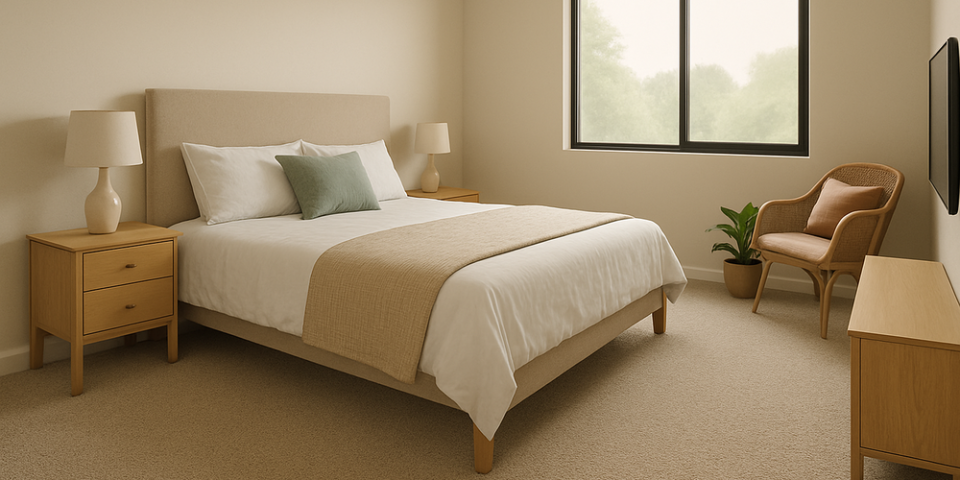
The Best Carpet Styles for Small Spaces
Decorating a small room doesn’t mean sacrificing style—or comfort. The right carpet can actually make a space feel larger, cozier, and more inviting. Whether you’re outfitting a small bedroom, office, or apartment, here are the best carpet styles to visually expand the room and match your lifestyle.
What to Look for in Carpet for Small Rooms
- Low to medium pile height – keeps the room from feeling crowded or heavy
- Light or neutral tones – reflects more light and opens up the space
- Minimal pattern – avoids visual clutter in tight quarters
- Soft texture – adds comfort without overwhelming the room
Top Carpet Styles for Small Spaces
1. Berber Carpet
Berber’s low looped pile is durable and low-profile, making it ideal for compact rooms. It holds up well in high-traffic areas and doesn’t trap dust—great for tight spaces with less airflow.
2. Cut and Loop Carpet
This blended style adds a bit of texture and design without overwhelming the room. Choose subtle patterns in neutral tones to maintain a sense of space.
3. Textured Plush Carpet
Plush carpet adds softness and warmth while the textured finish hides footprints and vacuum marks—perfect for small bedrooms or guest rooms.
Best Carpet Colors for Small Rooms
Light grays, soft taupes, and beiges are perfect for making a space feel more open. These tones bounce natural light around the room and pair easily with walls, bedding, or furniture.
Carpet Patterns: Yes or No?
In small rooms, less is more. If you want pattern, go for something subtle like tone-on-tone loops or faint lines. Stay away from bold prints or high-contrast designs that can make a room feel busy.
Pro Tip: Use Carpet to Define Zones
In studio apartments or multipurpose rooms, carpet can help define zones. A soft carpet in the sleeping nook creates separation from other areas—without using up square footage.
Don’t Forget Padding!
High-quality padding adds insulation and comfort—especially helpful in apartments or upstairs spaces where sound reduction matters.
Need More Style Ideas?
Check out our blog on carpet for busy households with kids or explore easy tips to keep carpet looking fresh.
Conclusion
When chosen wisely, carpet can be one of your best tools for making a small space feel bigger and better. Stick to low pile, soft tones, and simple patterns—and your small room will feel surprisingly spacious.
Need help choosing carpet for your apartment or guest room?
Browse our catalog or talk to the Carpet Cave team for expert help.

How to Get Red Wine Out of Carpet Without Ruining It
Spilled red wine on your carpet? Don’t panic—acting fast and using the right methods can help you avoid a permanent stain. In this guide, we’ll show you step-by-step how to remove red wine from carpet using safe, simple ingredients you may already have at home. No harsh chemicals or damage required!
Step 1: Blot—Don’t Rub!
As soon as the spill happens, gently blot the stain with a clean, dry cloth or paper towel. Use light pressure and avoid rubbing, which can push the wine deeper into the fibers. Work from the outside in to avoid spreading the stain.
Step 2: Apply Cold Water
Pour a small amount of cold water onto the stain to dilute it. Then blot again with a clean cloth. Repeat this step a few times if needed—diluting the stain makes it easier to lift later.
Step 3: Use a Vinegar and Dish Soap Solution
Mix this simple cleaning solution:
- 1 tablespoon white vinegar
- 1 tablespoon dish soap (clear is best)
- 2 cups cold water
Dip a clean cloth into the mixture and gently blot the stained area. Continue blotting until the stain begins to lift. Use another dry cloth to blot up excess liquid.
Step 4: Rinse with Water
Once the stain is mostly gone, rinse the area with a small amount of cold water and blot again. This helps remove any soapy residue that could attract dirt later.
Step 5: Optional – Use Baking Soda for Odor
If the wine has a lingering smell, sprinkle a light layer of baking soda over the damp spot. Let it sit for a few hours (or overnight), then vacuum it up. This helps neutralize odor and freshen the carpet.
What NOT to Do
- ❌ Don’t use hot water—it can set the stain
- ❌ Avoid scrubbing with a brush
- ❌ Don’t wait too long—the sooner you act, the better the results
When to Call the Pros
If the stain won’t lift or the carpet is white or light-colored, professional carpet cleaners may be able to remove it completely without damaging your floors.
Other Tough Carpet Stains?
Check out our blog on natural carpet deodorizing or explore tips for keeping your carpet looking new.
Conclusion
Red wine doesn’t have to mean red panic. With quick action and a few gentle cleaning tricks, you can remove wine stains from your carpet and keep your flooring looking its best.
Need carpet that’s easier to clean?
Explore our stain-resistant carpet options or contact Carpet Cave to talk with a flooring expert.
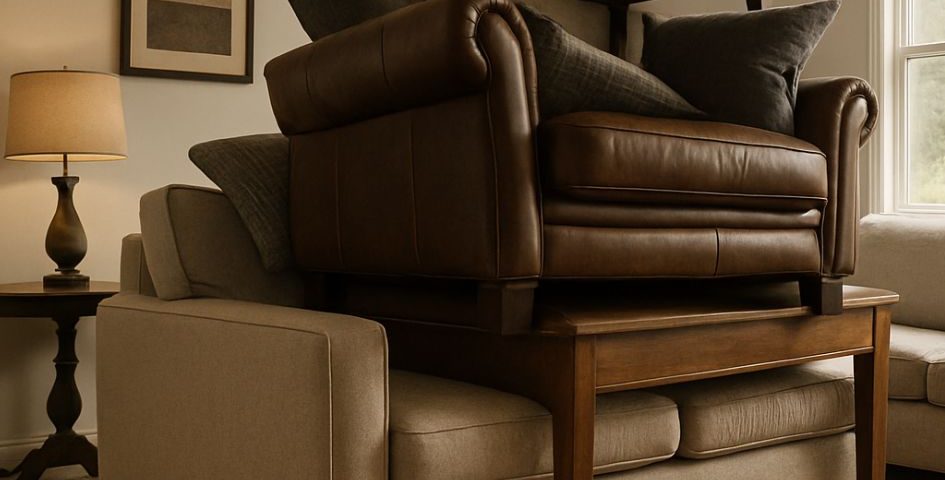
How to Protect Your Carpet from Heavy Furniture
You’ve invested in soft, beautiful carpet—but now you’re adding furniture and wondering: how do I keep heavy couches, beds, and tables from crushing or damaging it? Over time, furniture can cause dents, tears, or permanent flattening in your carpet. But don’t worry—there are simple, effective ways to prevent damage while keeping your space stylish and functional.
Why Heavy Furniture Damages Carpet
Carpet is made of fibers that bend under pressure. When heavy furniture sits in one spot for too long, the fibers get compressed and may not fully rebound. This leads to visible dents, worn areas, or permanent crushing. Some furniture can even snag or tear carpet backing if moved improperly.
Top Ways to Protect Carpet from Furniture Damage
1. Use Furniture Coasters or Pads
One of the easiest ways to prevent carpet dents is to place coasters or felt pads under your furniture legs. These small accessories distribute the weight more evenly and reduce pressure on the carpet fibers.
- Choose larger diameter coasters for extra-heavy items like beds or sectionals.
- Rubber or non-slip options can also keep furniture from shifting and bunching the carpet.
- You can find clear, low-profile designs that won’t clash with your decor.
2. Rearrange Furniture Occasionally
Even small adjustments can help relieve pressure on certain areas of the carpet. Rotate rugs, shift sofas, or swap accent chairs around every few months to keep wear even and minimize lasting indentations.
3. Use Rugs Under Furniture Legs
Placing area rugs or runners beneath furniture not only adds design interest—it also provides an added layer of protection. Rugs help absorb pressure and reduce direct contact with carpet fibers.
Check out our post on carpet vs. rugs to learn when layering makes the most sense for your space.
4. Choose Furniture with Wider Bases
When possible, select furniture pieces that have wide or flat bases. The more surface area in contact with the carpet, the less pressure is concentrated on a single point.
- Metal legs or thin wood feet are more likely to dent than broad platforms or box bases.
- Wide feet also reduce snagging or cutting risk when moving furniture.
5. Install Carpet with High-Density Padding
The right carpet padding helps prevent damage from below. High-density foam or memory foam pads provide better resistance against pressure and prolong the lifespan of your carpet. Ask your flooring installer about pad upgrades if you’re in the planning phase.
How to Fix Dents from Furniture in Carpet
Option 1: Ice Cube Trick
Place an ice cube in the dent and let it melt completely. The moisture will cause the fibers to swell back up. Once dry, gently fluff with a spoon or the edge of a credit card to raise the pile.
Option 2: Steam and Brush
Use a handheld steamer or a damp cloth with a hot iron (no direct contact) to warm the dented fibers. Then brush or rake them gently back into place. Be careful not to overheat or soak the carpet backing.
Option 3: Carpet Rake or Groomer
These tools are made specifically to lift and revive flattened fibers. Rake the affected area after vacuuming to restore appearance—especially helpful for high-pile or plush carpets.
Tips for Moving Furniture on Carpet
- Use sliders: Plastic or felt furniture sliders reduce friction and prevent snags when moving large items.
- Lift—don’t drag: Always lift heavy furniture slightly when shifting position, especially on soft or high-pile carpets.
- Wrap sharp corners: Use towels or foam wraps when moving to protect both carpet and walls.
Best Carpets for Homes with Heavy Furniture
1. Low-Pile Carpet
Tightly woven, low-pile carpets (like Berber or commercial loop styles) are more resistant to crushing and easier to maintain with furniture.
2. High-Density Carpet
Look for carpet options with higher density ratings. These provide more resilience under pressure and are less prone to permanent dents.
3. Stain-Resistant Fibers
If you’re moving furniture often or layering rugs, go with carpets made of nylon or triexta—both resist wear and are easy to clean.
Additional Protection for Homeowners and Renters
For Homeowners:
- Use high-quality carpet padding
- Invest in long-term coasters or furniture bases
- Consider rearranging rooms seasonally to distribute wear
For Renters:
- Use rugs under furniture to protect landlord-installed carpet
- Buy large felt pads or sliders—especially for couches and dining tables
- Fix any noticeable dents before moving out with ice cube or steam methods
Related Reading
Want to extend the life of your carpet? Read our 7 easy tips for keeping carpet looking new or explore our blog on

Carpet vs. Rugs: Which Is Better for Your Space?
If you’re designing or updating a space in your home, one of the first flooring questions that may come up is: carpet or rug? Both offer comfort, warmth, and visual interest—but they serve different purposes and offer distinct pros and cons. Whether you’re redoing a whole room or just want to soften the space under your feet, this guide will help you choose the best option for your needs, style, and budget.
What’s the Difference Between Carpet and Rugs?
Let’s start with the basics:
- Wall-to-wall carpet is installed from corner to corner and fixed to the floor. It’s a permanent flooring solution that covers the entire room and usually includes padding underneath.
- Area rugs are movable textile pieces placed on top of existing floors. They don’t require installation and can be rolled up, replaced, or moved as needed.
Both options come in a wide range of colors, materials, textures, and price points—but choosing between them depends on how you live, how you decorate, and what type of space you’re designing.
Pros of Carpet
1. Wall-to-Wall Comfort
Carpet offers full coverage, providing warmth and cushion across an entire room. It’s ideal for bedrooms, nurseries, and other spaces where comfort is a priority.
2. Sound Insulation
If you live in an apartment or have a multi-story home, carpet helps absorb sound—reducing footstep noise, echoes, and ambient sound transfer between floors.
3. Long-Term Cost Efficiency
Although carpet requires professional installation, it can be more cost-effective over time, especially in larger spaces. High-quality carpet can last 10–15 years or more with proper care.
4. Seamless Design
Wall-to-wall carpet provides a clean, cohesive look without visible breaks or movement. It anchors a room and often makes it feel more spacious and grounded.
Cons of Carpet
- Harder to clean: Spills and stains can be more difficult to remove, and you can’t simply replace one spot like you could with a rug.
- More commitment: Once installed, it’s not easy to change colors or patterns without full replacement.
- Installation required: You’ll need a pro to measure, cut, and install the carpet, adding to the initial cost and timeline.
Pros of Area Rugs
1. Flexibility and Style
Area rugs can be easily swapped out to match seasonal décor, trends, or mood changes. They’re perfect for adding color, texture, or personality to a room without a big commitment.
2. Easier Maintenance
Most rugs can be shaken out, spot-cleaned, or even tossed into a washing machine depending on size and material. You can also replace just one rug if damage occurs—no need for full-floor replacement.
3. Layering Opportunities
You can place rugs on top of wood, tile, laminate, or even carpet to define areas, add warmth, or break up large open spaces.
4. Portability
Rugs are great for renters or frequent movers—you can take them with you from home to home, room to room.
Cons of Area Rugs
- Can slip or bunch without proper padding
- Don’t offer full-floor insulation or coverage
- May require non-slip pads or furniture to anchor in place
When to Choose Carpet
- You want a quiet, cozy, insulated room
- You’re furnishing a bedroom, media room, or nursery
- You prefer a permanent flooring solution
- You want seamless wall-to-wall style
When to Choose Rugs
- You live in a rental or plan to move
- You like switching up your interior design
- You have wood or tile flooring and want to soften specific zones
- You want easier maintenance and flexibility
Can You Use Both?
Absolutely! Many homes use both carpet and rugs to layer warmth, define spaces, and add style. For example, you might use carpet in the bedrooms and hallway while placing a rug over hardwood in the living or dining room.
Some people even layer rugs over carpet—especially if the existing carpet is neutral. Just be sure to use a rug pad to prevent bunching or damage underneath.
Room-by-Room Recommendations
- Bedrooms: Carpet for full comfort or rugs for design flexibility
- Living Rooms: Rug over hardwood or LVP; carpet if you want softness wall-to-wall
- Dining Rooms: Rug only—carpet is harder to clean under tables
- Kids’ Rooms: Carpet is great for safety; rugs can add color and playfulness
- Home Offices: Either! Just avoid thick carpet if you’re using a wheeled chair
Want More Carpet Tips?
Check out our popular guide on how to keep your carpet looking new or explore our blog on the best carpet for homes with kids.
Conclusion
There’s no one-size-fits-all answer in the carpet vs. rug debate—it really comes down to your lifestyle, space, and goals. If you love comfort, insulation, and permanence, wall-to-wall carpet may be the way to go. If you value design flexibility and easy maintenance, rugs might win out. Either way, your floors can be stylish, functional, and totally you.
Need help deciding?
Browse our flooring catalog or chat with Carpet Cave to get personalized guidance on the best option for your home.
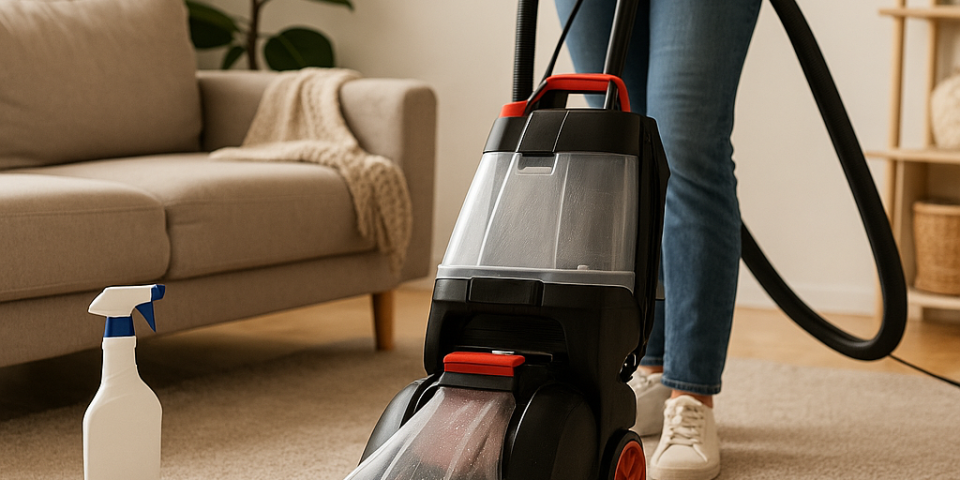
Should You Rent or Buy a Carpet Cleaner? (Pros and Cons)
If you’re dealing with stains, pet messes, or just regular wear and tear, cleaning your carpet is a must. But should you rent a carpet cleaner or invest in your own? The answer depends on your home, your budget, and how often you plan to clean. Let’s break down the pros and cons of each option to help you decide.
Pros of Renting a Carpet Cleaner
1. Lower Upfront Cost
Renting a cleaner from a store is usually cheaper in the short term—great for one-time deep cleans or move-out jobs.
2. Professional-Grade Equipment
Rental units often have stronger suction and larger water tanks than most home models, which can mean a deeper clean.
3. No Storage Needed
You return it after use, so it won’t take up space in your closet or utility room.
Cons of Renting
- Time-limited—you’re on the clock once you rent it
- May not be as clean or well-maintained as your own machine
- Cost adds up if you need to clean carpets frequently
Pros of Buying a Carpet Cleaner
1. Convenient Anytime Cleaning
With your own cleaner, you can tackle spills and messes immediately—no need to run to the store or wait for availability.
2. Saves Money Over Time
If you clean often (especially with kids or pets), owning can pay for itself after just a few uses.
3. Better for Spot-Cleaning
Smaller home models are ideal for quick touch-ups and smaller areas, not just full-room cleaning.
Cons of Buying
- Higher upfront cost compared to renting
- You’ll need storage space
- May require regular cleaning and maintenance
How Often Do You Clean?
If you’re cleaning carpets more than twice a year—or have a household with kids, pets, or high foot traffic—buying your own machine might be the better investment.
Related Reading
Looking for long-term maintenance tips? Don’t miss our blog on 7 easy ways to keep your carpet looking new.
Conclusion
Both renting and buying a carpet cleaner have their perks. If you clean often, owning a machine makes sense. But for occasional deep cleans, renting may be the better bet. Either way, keeping your carpets fresh helps extend their life and keep your home looking its best.
Need carpet that stands up to cleaning?
Browse Carpet Cave’s selection or get in touch to find the best carpet for your lifestyle.
